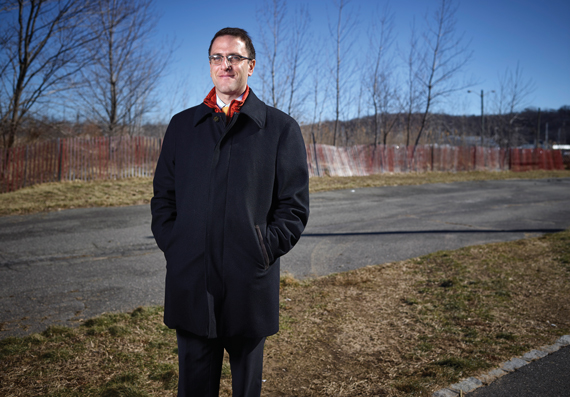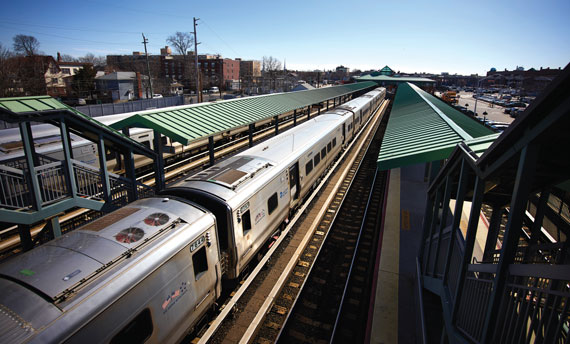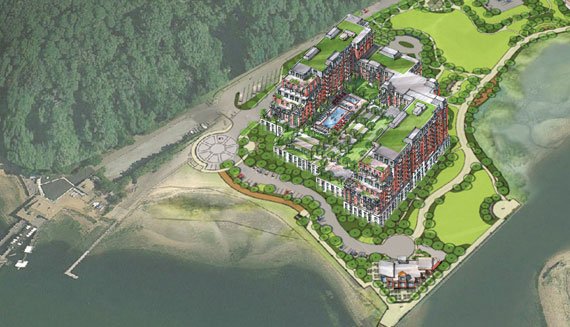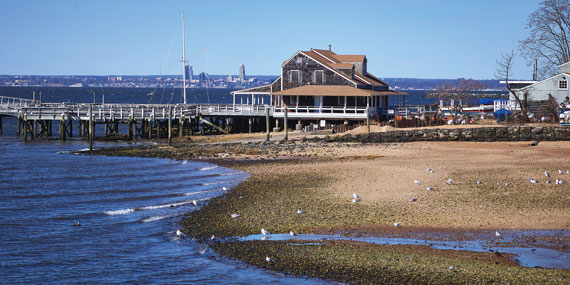Trending
Inside RXR’s massive bet on the suburbs beyond New York City
Seth Pinsky expects a great return to suburbia as prices in the city keep rising

From the Long Island Market Report: RXR Realty is perhaps best known in New York City real estate circles for owning some of the most high-profile office properties in Manhattan, including the Starrett-Lehigh Building and the Helmsley Building, which the company bought for $1.2 billion last May.
But behind the scenes, RXR has been implementing a complex, long-term strategy that could also see it become one of the largest players in the middle of suburbia. The Uniondale-based real estate giant hopes to turn the beleaguered downtowns of places like Long Island’s Hempstead and Glen Cove into thriving mixed-use hubs through the development of thousands of new housing units near train stations.
The firm hopes that these new housing complexes will draw millennials struggling to make rent in the five boroughs while also encouraging Long Island’s youth to stay put, rather than migrate to the city.
“RXR sees potential in places that many others have not only written off — they’ve fled from,” said Lawrence Levy, executive dean at the National Center for Suburban Studies at Hofstra University.
Seth Pinsky, an executive vice president at RXR and former president of the New York City Economic Development Corporation, said the strategy is based on the logical theory that people struggling to afford New York City rents will start following the suburban train lines, not just the inner-city subway lines, to find affordable homes.
“You’ve got a crisis in the city, where people can’t afford to live and all the right ingredients are here,” he told The Real Deal during a trip to see RXR’s latest projects in Nassau County. “To me, it seems obvious. Once you start looking at it, you think, ‘Why haven’t we been doing this all along?’”
RXR, led by CEO and Chairman Scott Rechler, is certainly not the only company to invest in providing multi-story alternatives to Long Island’s standard single-family homes, but it is the first to do so at such a remarkable scale. As part of the first phase of its plans, the company is in the midst of raising a nearly $400 million fund through its institutional partners to invest in emerging areas in the region.
But in swimming against the tide, the company is taking on a degree of risk.
“There’s the potential to make a lot of money, but there’s also a real chance to lose money,” Levy said. “A lot of these places have been down a long time. These are going to be slow dollars.”
The master builder
Speaking to a group of local residents at Hofstra last year, Long Island native Rechler said this was a “back to the future moment” for suburbia, which was formerly the Promised Land for city dwellers who had made enough money to finally live comfortably.

Hempstead Train Station
“For most of the post-World War II era, the New York region was a story of a thriving periphery and a rotting core,” he told attendees. “But by the turn of the millennium, that story had reversed itself. For many people, the traditional suburban model simply lost its luster.”
Construction of rental housing on Long Island came to a near standstill in the 1980s and 1990s and more than 22,000 rental units were converted to for-sale housing, according to the Long Island Index, a research study compiled by nonprofit the Rauch Foundation. Long Island’s population has also been relatively stagnant too, as the region steadily loses its youth. Its population has grown by just 1 percent a year since 1970, compared to the 6 percent a year it grew between 1930 and 1970.
Enter RXR. So far, the company has development interests in six suburban downtowns: Stamford, Conn.; Yonkers and New Rochelle in Upstate New York; and Glen Cove, Hempstead and Huntington Station on the Island.
“The demand is overwhelming,” said developer Don Monti of Renaissance and RXR’s partner in Hempstead, Huntington Station and New Rochelle. “Just about every new rental project on Long Island is 70 percent leased by the time it even opens. Unless Long Island revs up to satisfy that demand, we’ll continue to have an exodus of our young people.”
RXR invests in these areas in one of two ways. In Yonkers and Stamford, for instance, the company partnered with a local developer who had reached an impasse in finding financing for its own projects and was looking for an institutional partner.
But for its other projects, such as those in New Rochelle, Glen Cove, Hempstead and Huntington Station, the firm has worked with local governments to become the official master builder for their respective downtowns, giving it the right to acquire all municipally owned property at an appraised value. That arrangement also gives RXR and its partners a major role alongside the local communities in advising how the zoning laws should be amended to allow for greater density.
In Hempstead, RXR, through its partnership with local authorities and with co-developers Renaissance Development and Urban America, is getting ready to break ground on the first phase of what will ultimately be a mixed-use downtown hub. That redevelopment, once completed, will include 3,500 units of housing, 660,000 square feet of retail and office space, a 125-key hotel and more than 1 million square feet of new community-focused space.
And in Glen Cove, RXR plans to turn a former Brownfield site along Glen Cove Creek on the Long Island Sound into a new community called Garvies Point with 1,000 apartments, 25,000 square feet of retail and cultural space, 50,000 square feet of office space and 26 acres of public amenities and open space.
Upside, downside
For a developer seeking healthy returns, challenged areas of Long Island may not seem like ideal investment targets, with average rents significantly lower than in Brooklyn and Queens. But Pinksy said the projects still pencil out, since RXR has a relatively low-cost basis from the outset.

Garvies Point in Glen Cove
The company and its partners acquired the 14 municipally owned sites it needs to develop its project in Hempstead for $8 million, for instance, while the Glen Cove site is slated to trade for just $15 million (a price that was decided post-recession in 2009). At such low rates, the bulk of the financial burden for RXR will be in the construction of the projects themselves.
“The economics are clearly not as rich on the upside as they are in the city but the costs are also significantly lower,” Pinsky said. “You can make a healthy return if you find the right environment.”
Officials said they care less about the price the property sells for and more about the overall impact of these projects on their communities.
“The juice isn’t in the sale of the property,” Mayor Reggie Spinello of Glen Cove told TRD. “It’s what happens going forward — the jobs, the taxes, $40 million in payroll. The sales price is just a small part of a much bigger picture.”
While it sounds like a golden ticket for RXR, experts said such arrangements are not always as sweet as they sound. For one, the developer must fight to attract new residents to areas that have long suffered from bad reputations.
“The school district in Hempstead is considered to be just about the worst on Long Island,” Levy said. “While they’re working like crazy to bring it up, it’s a slow process. Until it’s accomplished, it’s going to be really hard to attract families with kids.”
Secondly, there’s the challenge of financing these projects, which, while potentially very profitable, are not within the wheelhouses of many banks and other lenders. While RXR has secured construction financing for the first phase of its Hempstead project, it still has to woo lenders to the five other downtown projects.
“The number of banks that are willing to do construction loans is less than the number that are willing to lend on stabilized assets,” Pinksy said. “That number becomes even smaller when you are talking about suburban markets.”
Lastly, RXR must contend with a variety of different municipalities — and their respective school boards, water boards and library boards — as well as the rampant NIMBYism that has long stunted Long Island’s growth.
The Village of Sea Cliff even filed an article 78 lawsuit in The Supreme Court of the State of New York last year against the City of Glen Cove, its planning board, city council and the development partners in a bid to stop the project. The lawsuit claimed it would turn “a bucolic waterfront, environmentally sensitive land into a gigantic, sprawling, and super-densely-packed subdivision.”
“Anytime you have a project that’s this transformational, you’ll have people that object to it,” said Mayor Spinello. “One of the reasons that suburbia suffers is that there are these NIMBYs. Whatever you propose, they’ll say no, without even knowing the facts or having all the information.”

The end of Garvies Point Road, adjacent to the planned site
Levy agreed: “You get a lot of publicity for being the knight on the white horse coming to save a beleaguered community but you also become a lightning rod for all sorts of grievances either directly or indirectly related to the project,” he said.
“There are some people in poorer communities who don’t like the idea of gentrification and they fear the displacement of residences and businesses,” he added. “No matter how big you are, or think you are, you have to go visit people literally in their living rooms, church basements and at their soccer fields if you want them to approve your project.”
The activists who oppose the Glen Cove development “look at it as some $7 billion company coming in and taking away their land,” Spinello said.
“We’ve made it a policy not to go into areas where we’re going to be fighting city hall. We don’t want a knock ‘em down and drag ‘em out battle,” Pinsky said. “But, even in areas that have been receptive to development, doing development is something that will always arouse opposition from someone.”
Still, RXR believes it’s uniquely positioned to tackle the challenge of community engagement, thanks to its long-term ties to Long Island.
After all, Rechler grew up in Port Washington and Roslyn in a prominent Long Island real estate family. His grandfather formed Reckson Associates in 1968 with his sons Donald and Roger (Scott’s father) to build Long Island office buildings. While he sold Reckson in 2006, Rechler still has deep ties to the area and still has his office in Uniondale.
“A lot of Long Islanders have no idea about the big portfolio he controls in Manhattan,” Levy said. “They know him as part of the Rechler family. He’s a guy who’s persuaded a lot of people that he cares about these places.”




